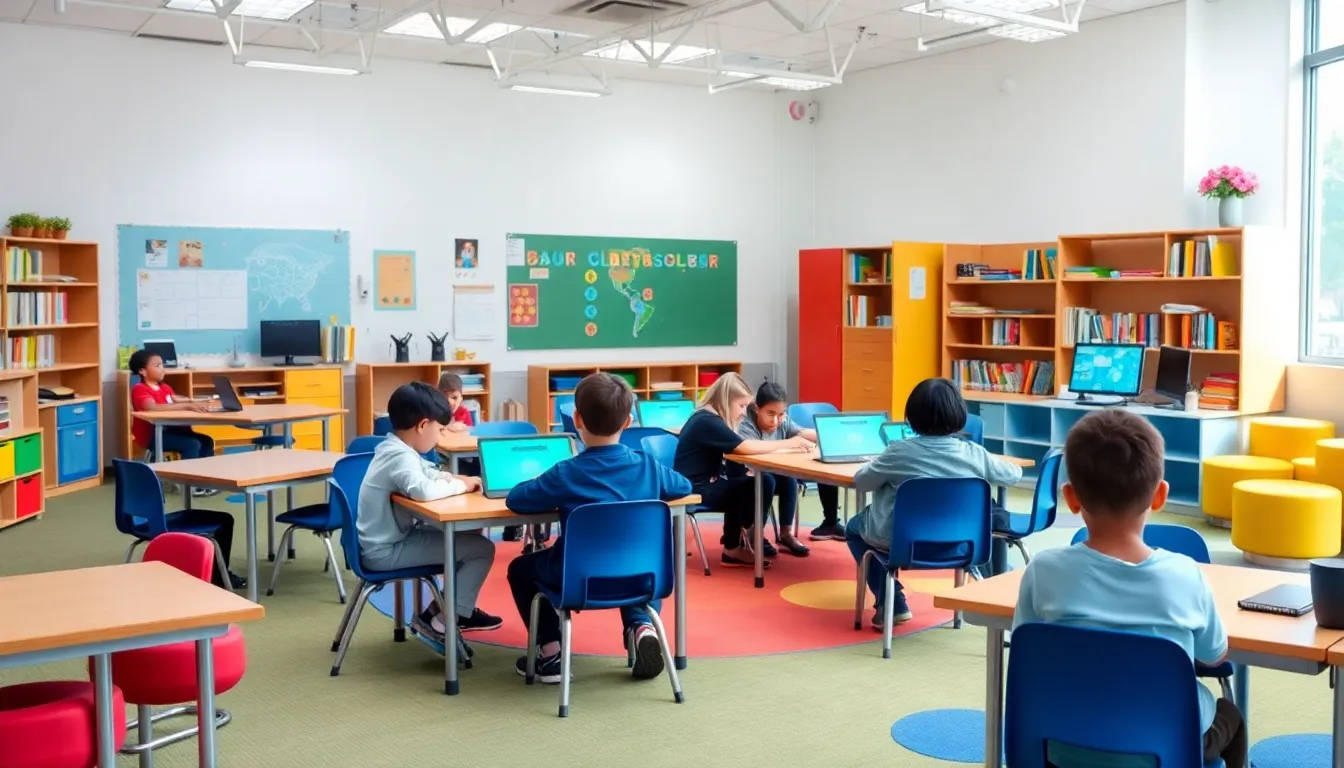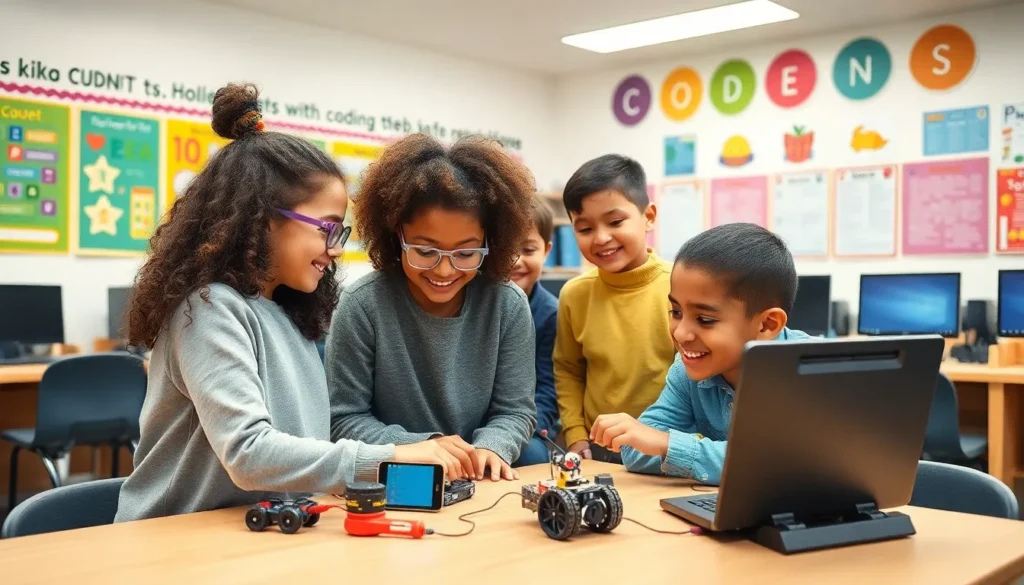In a world where kids are glued to screens more than ever, high tech elementary schools are revolutionizing the way young minds learn. Imagine classrooms buzzing with excitement as students dive into coding, robotics, and virtual reality, all while mastering the fundamentals of reading and math. It’s not just about flashy gadgets; it’s about preparing the next generation for a future that’s already here.
Gone are the days of dusty chalkboards and boring textbooks. Today’s elementary education embraces technology to ignite curiosity and creativity. With interactive lessons and hands-on projects, kids aren’t just learning—they’re having a blast! So, buckle up as we explore how high tech elementary schools are transforming education into an adventure that’s as fun as it is educational.
Table of Contents
ToggleHigh Tech Elementary Overview
High tech elementary schools leverage advanced technology to enhance learning. These institutions integrate coding, robotics, and virtual reality into their curricula. Engaging students through interactive lessons promotes curiosity and fosters creativity.
Students experience hands-on projects that make complex concepts more accessible. Hands-on learning encourages collaboration among peers, facilitating skill development in problem-solving and teamwork. Additionally, virtual reality applications immerse learners in diverse environments, enriching their educational experience.
Teachers adopt innovative tools to create dynamic lesson plans. Instructional methods shift from traditional lectures to interactive activities, capturing students’ attention and stimulating interest. High technology opens opportunities for personalized learning, catering to individual strengths and weaknesses.
Assessments in high tech environments often utilize digital tools. Real-time feedback enables educators to adjust teaching strategies based on student performance. This adaptability ensures all students progress, maximizing their potential.
Parental involvement also benefits from technology. Communication platforms allow families to stay informed about classroom activities and student achievements. Engaged parents contribute to a supportive learning atmosphere, reinforcing the education students receive.
High tech elementary schools represent a new paradigm in education. They prepare students for future challenges by equipping them with essential skills. As technology continues to evolve, these schools remain at the forefront of educational innovation, shaping the next generation of learners.
Key Features of High Tech Elementary

High tech elementary schools transform learning through various features that support student engagement and skill development. These schools create interactive environments that foster curiosity and creativity.
Innovative Learning Environments
Innovative learning environments play a crucial role in a student’s educational experience. Classrooms often utilize flexible seating arrangements, adaptable spaces, and dedicated tech zones that promote collaboration. Learning areas include areas designed for group projects or quiet reflection, enabling students to choose spaces that suit their needs. Bright colors and engaging visual displays stimulate interest and enhance focus. Teachers actively incorporate modern furniture and learning tools to encourage exploration and discovery, ensuring that every student feels included and motivated.
Integration of Technology in Curriculum
The integration of technology in the curriculum enhances traditional learning methods. Digital tools such as tablets and computers facilitate greater access to information and resources. Curriculum often includes coding, robotics, and digital storytelling, making learning relevant in today’s digital age. Teachers design lessons that use technology to demonstrate concepts in engaging ways, capturing students’ attention and promoting participation. Virtual field trips and interactive simulations bring abstract concepts to life, offering hands-on experiences that deepen understanding and retention. This integration inspires students and prepares them for future academic and career paths.
Benefits of High Tech Elementary Education
High tech elementary education transforms traditional learning methods to boost student participation.
Enhancing Student Engagement
Interactive tools capture learners’ attention effectively. Gamified lessons encourage participation, inspiring students to explore topics deeply. Collaborative projects foster teamwork, allowing learners to share ideas and skills. Technology-driven assignments make learning fun and relevant, nurturing curiosity. Students can interact with content through various platforms, enhancing understanding and retention. Moreover, teachers can adapt materials based on real-time feedback, tailoring instruction to meet students’ needs.
Preparing for the Future Job Market
Skills acquired in high tech elementary schools align with evolving job market demands. Emphasis on coding and robotics cultivates critical thinking and problem-solving abilities. Digital literacy enhances students’ competence in technology use. Exposure to innovative tools prepares them for careers in fields like engineering and programming. Students learn to collaborate in a tech-driven environment, mimicking real-world workplace scenarios. Additionally, strong communication skills developed through presentations increase their competitiveness. They enter the workforce equipped with relevant skills and experiences that support future success.
Challenges Faced by High Tech Elementary Schools
High tech elementary schools encounter several challenges that can affect their effectiveness. Funding issues often hinder the acquisition of advanced technology and resources needed for optimal learning experiences. Teachers may find it difficult to keep up with rapidly evolving tech tools, leading to disparities in implementation across classrooms.
Professional development opportunities are essential yet frequently underfunded, limiting educators’ abilities to integrate technology seamlessly. Classroom management also poses challenges as the increased use of technology can distract students and complicate traditional teaching methods.
Equity in access becomes a concern when some students lack reliable internet access or devices at home, creating disparities in learning opportunities. Communication between teachers and parents might suffer due to varied levels of tech proficiency among families.
Moreover, curriculum development presents its obstacles, with educators needing to align standards with tech-driven lessons while ensuring foundational skills are not overlooked. Balancing creativity and structured learning is crucial yet sometimes difficult as educators strive to engage students in meaningful ways.
Feedback and assessments in tech-rich environments can overwhelm educators if not managed effectively, as immediate responses may lead to additional stress. Schools may also face pressure to show measurable results from their technology investments, leading to a focus on standardized testing rather than holistic development.
Despite these hurdles, collaborative efforts among educators, administrators, and the community can foster solutions that enhance the high tech educational landscape. Investing in training, infrastructure, and collaboration can address many of these challenges, ensuring high tech elementary schools meet their transformative potential.
High tech elementary schools are reshaping the educational landscape by embracing technology to enhance learning experiences. The shift towards interactive and hands-on approaches not only captivates students but also equips them with essential skills for the future. As these schools continue to innovate, they foster collaboration and creativity while preparing students for the demands of a rapidly evolving job market.
Despite facing challenges such as funding and resource limitations, the potential for high tech schools to transform education remains significant. By prioritizing professional development and community involvement, educators can navigate these hurdles effectively. The commitment to integrating technology in meaningful ways ensures that students thrive in an increasingly digital world. Embracing this new paradigm is vital for nurturing the next generation of thinkers and problem solvers.





